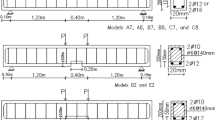Abstract
This study deals with the deformation characteristics of epoxy-modified concrete (EMC) under uniaxial and repeated compressive load with a view to evaluate its potential for use in structures that are subjected to in-service deformations under seismic conditions. A series of concrete specimens were prepared with epoxy resin either as the only binder or as co-binder jointly with the conventional binder, Portland cement. The specimens were evaluated on the basis of mechanical strength and deformability. The modulus of elasticity and the Poisson’s ratio of the EMC have been compared with conventional Portland cement concrete (CC).The first exhibits much higher axial and lateral deformation capacity than the later, a clear indication of higher energy-dissipation ability and ductility.







Similar content being viewed by others
Data availability
Some or all data, models or code that support the findings of this study are available from corresponding author upon reasonable request.
References
Elalaoui, O., Ghorbel, E., Mignot, V., & Ouezdou, M. B. (2012). Mechanical and physical properties of epoxy polymer concrete after exposure to temperatures up to 250 degree centigrade. Construction and Building Materials, 27(1), 415–424.
El-Howary, M. M., Alkhaleefi, A. M., & Abdel-Fattah, H. I. (2005). Short paper on the mechanical properties of polymer Portland cement concrete. Journal of Chinese Institute of Engineer, 28(1), 155–159.
Fattah, H. A., & El-Howary, M. M. (1999). Flexural behavior of polymer concrete. Construction and Building Materials, 13(5), 253–262.
Ferdous, W., Manalo, A., Wong, H. S., Abousnina, R., Alajarmeh, O. S., Zhuge, Y., & Schubel, P. (2020). Optimal design for epoxy polymer concrete based on mechanical properties and durability aspects. Construction and Building Materials, 232, 117229. https://doi.org/10.1016/j.conbuildmat.2019.117229
Fernández-ruiz, M. A., Gil-martín, L. M., Carbonell-márquez, J. F., & Hernández-montes, E. (2018). Epoxy resin and ground tyre rubber replacement for cement in concrete: Compressive behaviour and durability properties. Construction and Building Materials, 173, 49–57. https://doi.org/10.1016/j.conbuildmat.2018.04.004
Gil-martín, L. M., Rodríguez-suesca, A. E., Fernández-ruiz, M. A., & Hernández-montes, E. (2019). Cyclic behavior of RC beam-column joints with epoxy resin and ground tire rubber as partial cement replacement. Construction and Building Materials., 211, 659. https://doi.org/10.1016/j.conbuildmat.2019.03.216
Golestaneh, M., Amini, G., Najafpour, G., & Beygi, M. (2010). Evaluation of mechanical strength of epoxy polymerconcrete with silica powder as filler. World Applied Sciences Journal, 9(2), 216–220.
Ji, N., Yeon, J., Seung, I., & Yeon, K. (2017). Effects of curing temperature and hardener type on the mechanical properties of bisphenol F-type epoxy resin concrete. Construction and Building Materials, 156, 933–943. https://doi.org/10.1016/j.conbuildmat.2017.09.053
Jiratatprasot, P. (2002). Mechanical properties and stress strain behavior of high performance concrete under uniaxial compression. New Jersey Institute of Technology.
Penelis, K. A. (1997). Earthquake-resistant concrete structures (1st ed.). E & FN SPON.
Rahman, M. M., & Islam, M. A. (2013a). Epoxy resin-based concrete: Preparation and properties. Indian Concrete Journal, 87(11), 18–26.
Rahman, M. M., & Islam, M. A. (2013b). Contribution of rice husk ash to the performance of polymer mortar and polymer concrete. Journal of Polymer Engineering, 33(4), 377–387. https://doi.org/10.1515/polyeng-2013-0078.
Rahman, M. M., Islam, M. A., & Uddin, M. T. (2016). Excellent durability of epoxy modified mortars in corrosive environments. Journal of Polymer Engineering, 36(1), 79–85. https://doi.org/10.1515/polyeng-2015-0105
Reis, J. M. L., & Ferreira, A. J. M. (2004). Assessment of fracture properties of epoxy polymer concrete reinforced with short carbon and glass fibers. Construction and Building Materials. https://doi.org/10.1016/j.conbuildmat.2004.04.010
Roh, I.-T., Jung, K.-C., & Chang, S.-H. (2015). Characterization of compliant polymer concretes for rapid repair of runways. Construction and Building Materials, 78, 77.
Shao, J., Zhu, H., Zuo, X., Lei, W., Borito, S. M., Liang, J., & Duan, F. (2020). Effect of waste rubber particles on the mechanical performance and deformation properties of epoxy concrete for repair. Construction and Building Materials, 241, 118008. https://doi.org/10.1016/j.conbuildmat.2020.118008
Xiao, T. Y. Q. G., & Teng, J. G. (2011). Behavior and modeling of confined high-strength concrete. Journal of Composites for Construction ASCE, 14, 249–259.
Yeon, K., Heum, J., Choi, Y., & Min, S. (2014). Deformation behavior of acrylic polymer concrete: Effects of methacrylic acid and curing temperature. Construction and Building Materials, 63, 125–131. https://doi.org/10.1016/j.conbuildmat.2014.04.051
Zeng, J., Ye, Y., Gao, W., Smith, S. T., & Guo, Y. (2020). Stress-strain behavior of polyethylene terephthalate fiber-reinforced polymer-confined normal- , high- and ultra high-strength concrete. Journal of Building Engineering, 30, 101243.
Acknowledgements
The authors are thankful to Housing and Building Research Institute, Dhaka for their laboratory support, and Department of Chemical Engineering and Polymer Science of Shahjalal University of Science and Technology.
Funding
This study was supported by Housing and Building Research Institute and Department of Chemical Engineering and Polymer Science of Shahjalal University of Science and Technology, Sylhet.
Author information
Authors and Affiliations
Contributions
First author has conducted experimental studies, prepared the manuscript under the supervision of second author.
Corresponding author
Ethics declarations
Conflict of interest
The authors declare that they have no known competing financial interests or personal relationships that could have appeared to influence the work reported in this paper.
Additional information
Publisher's Note
Springer Nature remains neutral with regard to jurisdictional claims in published maps and institutional affiliations.
Rights and permissions
About this article
Cite this article
Rahman, M.M., Islam, M.A. Deformation behavior of epoxy-modified high strength concrete under uniaxial and repeated compression load. Asian J Civ Eng 23, 219–227 (2022). https://doi.org/10.1007/s42107-022-00419-x
Received:
Accepted:
Published:
Issue Date:
DOI: https://doi.org/10.1007/s42107-022-00419-x




